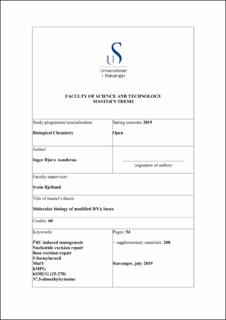| dc.contributor.advisor | Bjelland, Svein | |
| dc.contributor.author | Aanderaa, Inger Djuve | |
| dc.date.accessioned | 2022-12-28T12:41:06Z | |
| dc.date.available | 2022-12-28T12:41:06Z | |
| dc.date.issued | 2019-08 | |
| dc.identifier.uri | https://hdl.handle.net/11250/3039654 | |
| dc.description | Master's thesis in Biological Chemistry | en_US |
| dc.description.abstract | The cell has several mechanisms for repairing DNA damages, and it has been widely accepted that the base excision repair (BER) pathway is the main repair mechanism for small non helix distorting damages caused by oxidation. However, evidence exists that the nucleotide excision repair (NER) pathway plays a role in repair of oxidized bases in mammalian cells in vitro. To investigate if the NER pathway is involved in repair of oxidized bases in vivo, exponentially growing E. coli cells were exposed to 0.1 mM 5-formyldeoxyuridine (f5dU) followed by analyzing the mutations caused in the rpoB+ gene. Previous experiments performed within our group indicated that the uvrA+ gene was highly involved in promoting mutations caused by exposure to 5-formyldeoxyuridine. This thesis work combined with results from previously performed experiments within the same study, show that all the three Uvr proteins are involved in promoting ATGC mutations at sites 1534 and 1547 within the rpoB+ gene following exposure to a low concentration of f5dU. An indication that there might also be an unknown function of UvrA is something that needs to be further investigated.
5-methylcytosin (m5C) is recognized as the most important epigenetic DNA base in mammalian cells, yet relatively few studies have investigated damaging chemical alterations to this important DNA base. Certain methylases expressed by prokaryotes can convert m5C to N4,5-dimethylcytosine (mN4,5C) in vitro and it is therefore a possibility of mN4,5C existing in vivo. MutY, hMPG and a truncated version of hSMUG1 (hSMUG 25-270) were investigated for activity against mN4,5C in vitro. Short fluorescently tagged oligodeoxyribonucleotides with mN4,5C inserted at a specific position were hybridized with complimentary oligodeoxyribonucleotides with A, C, G or T placed opposite the damaged base, followed by incubation with the abovementioned enzymes. Denaturing PAGE was used to determine incision activity. None of the tested enzymes showed any activity against the lesion. | en_US |
| dc.language.iso | eng | en_US |
| dc.publisher | University of Stavanger, Norway | en_US |
| dc.relation.ispartofseries | Masteroppgave/UIS-TN-IKBM/2019; | |
| dc.rights | Attribution-NonCommercial-NoDerivatives 4.0 Internasjonal | * |
| dc.rights.uri | http://creativecommons.org/licenses/by-nc-nd/4.0/deed.no | * |
| dc.subject | biologisk kjemi | en_US |
| dc.subject | molekylærbiologi | en_US |
| dc.subject | f5dU induced mutagenesis | en_US |
| dc.subject | Nucleotide excision repair | en_US |
| dc.subject | Base excision repair | en_US |
| dc.subject | 5-formyluracil | en_US |
| dc.subject | MutY | en_US |
| dc.subject | hMPG | en_US |
| dc.subject | hSMUG (25-270) | en_US |
| dc.subject | N4,5-dimethylcytosine | en_US |
| dc.title | Molecular biology of modified DNA bases | en_US |
| dc.type | Master thesis | en_US |
| dc.subject.nsi | VDP::Matematikk og Naturvitenskap: 400::Kjemi: 440 | en_US |
| dc.subject.nsi | VDP::Matematikk og Naturvitenskap: 400::Basale biofag: 470::Biokjemi: 476 | en_US |

